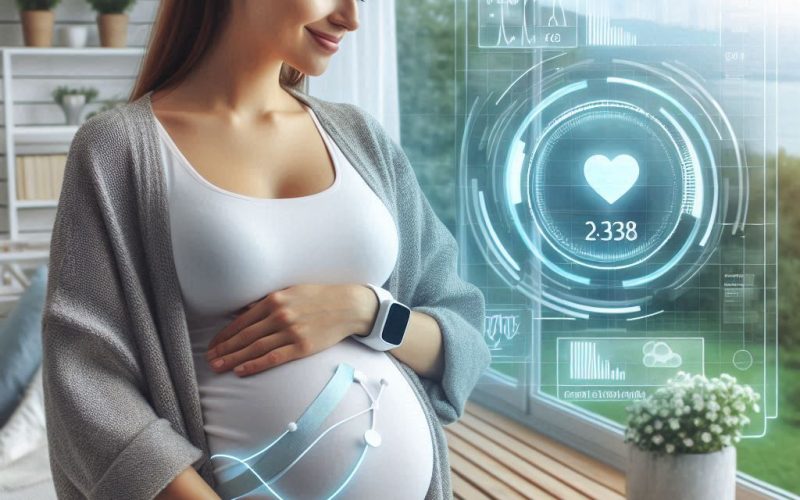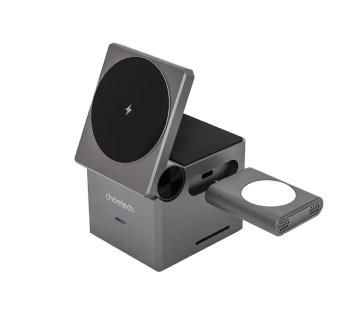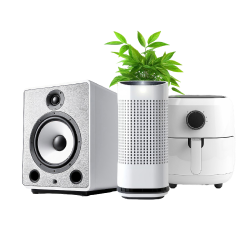Pregnancy is a transformative journey, marked by both joyous anticipation and a myriad of health considerations. Ensuring optimal maternal and fetal health throughout the gestational period is paramount.
Traditional prenatal care, while effective, often involves periodic check-ups and assessments that may not capture the dynamic nature of pregnancy on a day-to-day basis. This is where wearable technologies come into play, offering a modern solution to enhance prenatal care and provide continuous monitoring.
Women's health pregnancy wearables are revolutionizing how expecting mothers and healthcare providers manage and monitor pregnancy, providing real-time data and actionable insights.
Benefits of Using Wearable Technologies During Pregnancy
Continuous Monitoring
One of the most significant benefits of pregnancy wearables is the ability to continuously monitor vital health parameters. This continuous stream of data can help detect anomalies early, allowing for timely medical intervention.
For instance, wearables can track heart rate variability, which can indicate potential issues like gestational hypertension or preeclampsia before they become severe. Additionally, continuous glucose monitoring can be crucial for managing gestational diabetes, ensuring both mother and baby remain healthy.
Enhanced Prenatal Care
Wearable technologies can supplement traditional prenatal visits by providing additional data points. This can lead to more informed decisions and personalized care plans. According to a study published in the Journal of Medical Internet Research, wearables significantly improved maternal health outcomes by enabling better monitoring and early detection of potential issues.
Furthermore, these devices can help in tracking weight gain, nutrition, and physical activity levels, ensuring that expecting mothers maintain a healthy lifestyle throughout their pregnancy.
Peace of Mind
For expecting mothers, the ability to monitor their health and that of their unborn baby can provide significant peace of mind. Knowing that they can track their health metrics in real-time helps reduce anxiety and stress, contributing to a healthier pregnancy.
A research article in BMC Pregnancy and Childbirth highlighted that women who used pregnancy wearables reported lower stress levels due to the reassurance provided by continuous monitoring.
Convenience
Women's health pregnancy wearables offer unparalleled convenience. They allow expecting mothers to monitor their health from the comfort of their homes without the need for frequent clinic visits. This convenience is particularly beneficial in times when mobility is limited or healthcare resources are stretched thin.
During the COVID-19 pandemic, for instance, the use of wearables surged as they provided a safe and effective way to monitor health without exposing mothers to potential infection risks in healthcare settings.
Improved Sleep Quality
Sleep is crucial for both maternal and fetal health. Wearables that track sleep patterns can help identify issues such as sleep apnea or insomnia, which are common during pregnancy.
By providing insights into sleep quality and duration, these devices enable expecting mothers to make necessary adjustments, such as improving sleep hygiene or seeking medical advice if needed.
Early Detection of Preterm Labor
Some advanced pregnancy wearables can monitor uterine contractions and provide early warnings of preterm labor. This early detection can be life-saving, allowing mothers to seek immediate medical attention and potentially prevent premature births.
Devices like the Bloomlife contraction monitor are designed specifically for this purpose, providing real-time data on contraction patterns.
Nutritional Monitoring
Proper nutrition is vital during pregnancy. Wearable technologies can help track dietary intake and ensure that mothers are getting the necessary nutrients.
Some wearables offer features like food logging and nutrient tracking, helping to identify any deficiencies and enabling timely dietary adjustments.
Physical Activity Tracking
Maintaining an appropriate level of physical activity is important for a healthy pregnancy. Wearables can monitor activity levels, ensuring that expecting mothers remain active without overexerting themselves.
They can track steps, monitor heart rate during exercise, and even suggest pregnancy-safe workouts. Staying active helps manage weight gain, reduce the risk of gestational diabetes, and improve overall well-being.
Customization and Alerts
Many pregnancy wearables offer customizable alerts for specific health parameters. For example, they can notify users if their heart rate exceeds a certain threshold, if their blood pressure is too high, or if they haven’t met their daily activity goals.
These alerts can prompt immediate action, whether it’s adjusting activity levels, seeking medical advice, or making dietary changes.
Integration with Health Apps
Wearables often integrate seamlessly with health apps, providing a holistic view of maternal health.
These apps can consolidate data from various sources, including fitness trackers, smart scales, and blood pressure monitors, into one comprehensive platform. This integration allows for a more detailed analysis of health trends and facilitates better communication with healthcare providers.
Types of Wearable Technologies for Pregnancy
While there are many great wearable technologies for pregnant women in the world, it might be a bit challenging to choose one. Here are all the possible types of wearables so that you can have an overall idea.
Smart Watches and Fitness Trackers
These are perhaps the most common types of wearables used during pregnancy. They monitor a range of metrics, including heart rate, sleep patterns, and physical activity. Brands like Apple Watch and Fitbit offer specific features tailored to pregnancy, such as guided breathing exercises and activity tracking designed for pregnant women.
Fetal Monitoring Devices
These specialized wearables are designed to monitor fetal heart rate and movement. Devices like the Owlet Band and Bloomlife provide real-time insights into fetal health, allowing mothers to track their baby’s development and well-being.
Smart Clothing
Innovations in textile technology have led to the development of smart clothing embedded with sensors. These garments can monitor a variety of metrics, such as body temperature and fetal movements. Smart maternity belts and bras are examples of how clothing is being integrated with technology to support pregnancy health.
Blood Pressure Monitors
High blood pressure is a common concern during pregnancy. Wearable blood pressure monitors allow for continuous tracking, helping to identify any issues early. Devices like the QardioArm and Omron HeartGuide are popular choices for expecting mothers.
Sleep Trackers
Sleep is crucial during pregnancy, but it can be elusive due to various discomforts. Wearable sleep trackers provide insights into sleep patterns and quality, helping women make necessary adjustments to improve their rest.
Key Features to Consider in Pregnancy Wearables
Now that you are already familiar with most of the wearables, it’s time to understand the key factors and features when purchasing your own pregnancy wearables.
Accuracy
The accuracy of data is paramount when it comes to health monitoring. Expecting mothers should choose wearables that are clinically validated and have a reputation for reliability. Devices that offer medical-grade accuracy are preferable. For example, wearable devices like the Apple Watch Series 6 have been clinically validated for heart rate monitoring, ensuring that the data they provide is trustworthy.
Comfort
Given the physical changes during pregnancy, comfort is a key consideration. Wearables should be lightweight, non-restrictive, and made from hypoallergenic materials to prevent skin irritation. For instance, smart clothing like the Owlet Band is designed with comfort in mind, using soft, stretchable fabric that adapts to the body’s changing shape.
Battery Life
Long battery life is essential for continuous monitoring. Frequent charging can be inconvenient, so devices with extended battery life are more practical for expecting mothers. Devices like the Garmin Vivosmart 4 offer up to seven days of battery life, making them ideal for continuous use without the hassle of frequent recharging.
Ease of Use
User-friendly interfaces and easy setup are important features. Wearables should be simple to operate, with intuitive apps that display data clearly and offer actionable insights. For example, the Fitbit app provides a straightforward interface that allows users to easily track their health metrics and receive personalized feedback.
Compatibility with Healthcare Providers
It’s beneficial if wearable technology can easily share data with healthcare providers. This integration allows doctors to monitor the data remotely and provide timely advice or interventions. Many wearables now offer features that sync data with electronic health records, facilitating seamless communication between patients and healthcare providers.
Customization and Alerts
Customizable alerts for specific health parameters can be invaluable. For instance, wearables that notify users of abnormal heart rates, blood pressure readings, or decreased fetal movements can prompt immediate action. The Apple Watch, for example, allows users to set customized heart rate alerts, ensuring that any deviations from the norm are quickly addressed.
Durability and Water Resistance
Durability is another key feature to consider, especially since wearables are meant to be used continuously. Water-resistant devices are particularly useful, as they can be worn during various activities, including showering and swimming. The Fitbit Charge 4, for instance, is water-resistant up to 50 meters, making it a robust option for active expecting mothers.
Data Security and Privacy
With the increasing amount of personal health data being collected, data security and privacy are critical considerations. Expecting mothers should ensure that the wearable devices they choose comply with health data protection regulations such as HIPAA. Companies like Apple and Fitbit prioritize user privacy, implementing robust security measures to protect user data.
Cost and Affordability
While some high-end wearables offer extensive features, they can be quite expensive. It’s important to consider the cost and whether the features justify the price. There are many budget-friendly options available that still offer essential monitoring features. For example, the Mi Band series from Xiaomi provides comprehensive health tracking at a fraction of the cost of more premium devices.
Conclusion
As technology advances, the options for wearable devices will continue to expand, offering even more sophisticated and personalized monitoring solutions. For expecting mothers, integrating these wearables into their prenatal care routine can lead to healthier pregnancies and better outcomes for both mother and baby.
Investing in the right wearable technology requires careful consideration of factors such as accuracy, comfort, and ease of use. By choosing devices that meet these criteria, expecting mothers can enjoy the many benefits of continuous health monitoring, from early detection of potential issues to enhanced communication with healthcare providers.
With the right wearable technology, the path to motherhood can be a little smoother, a little safer, and a lot more informed.



